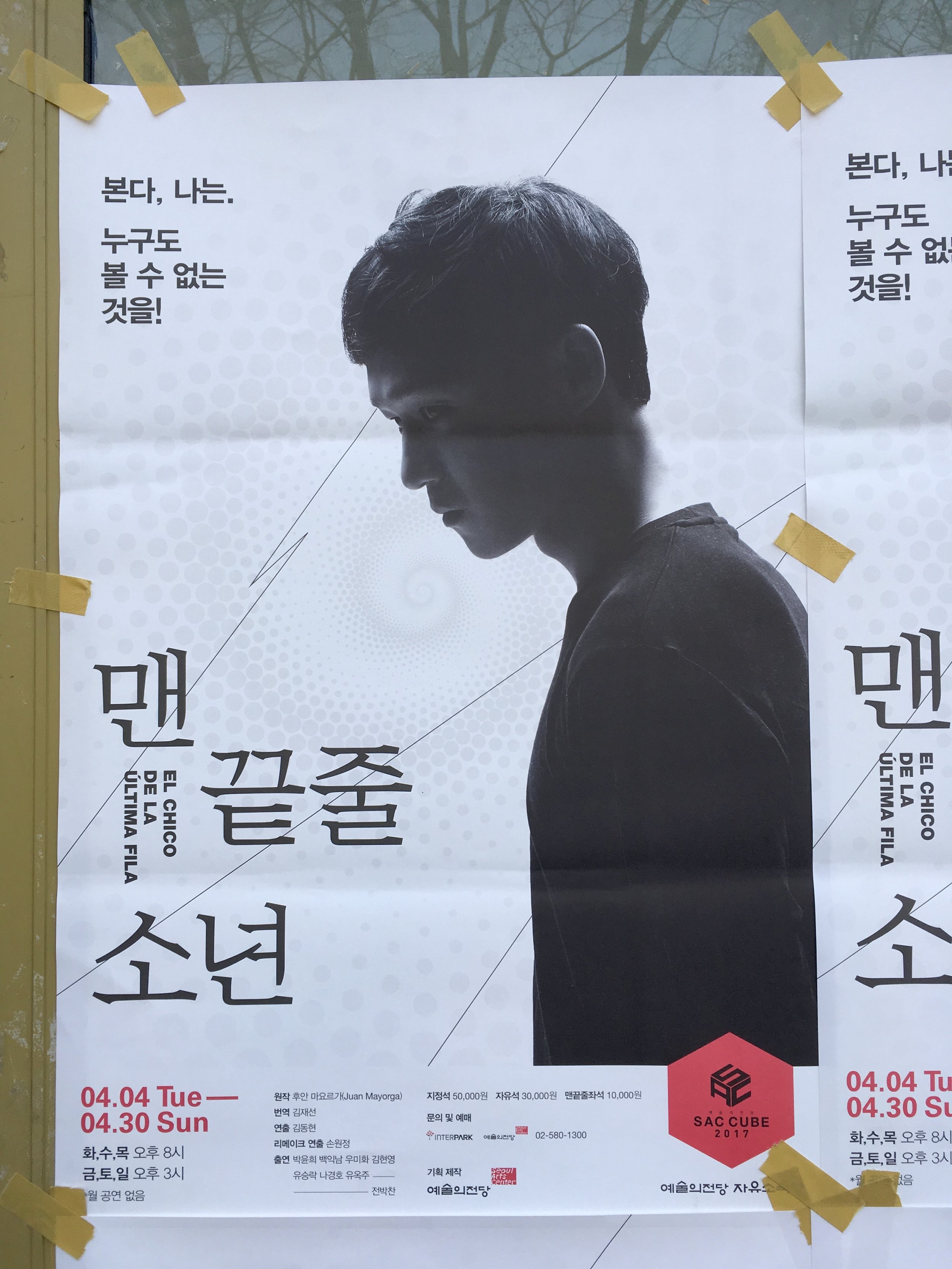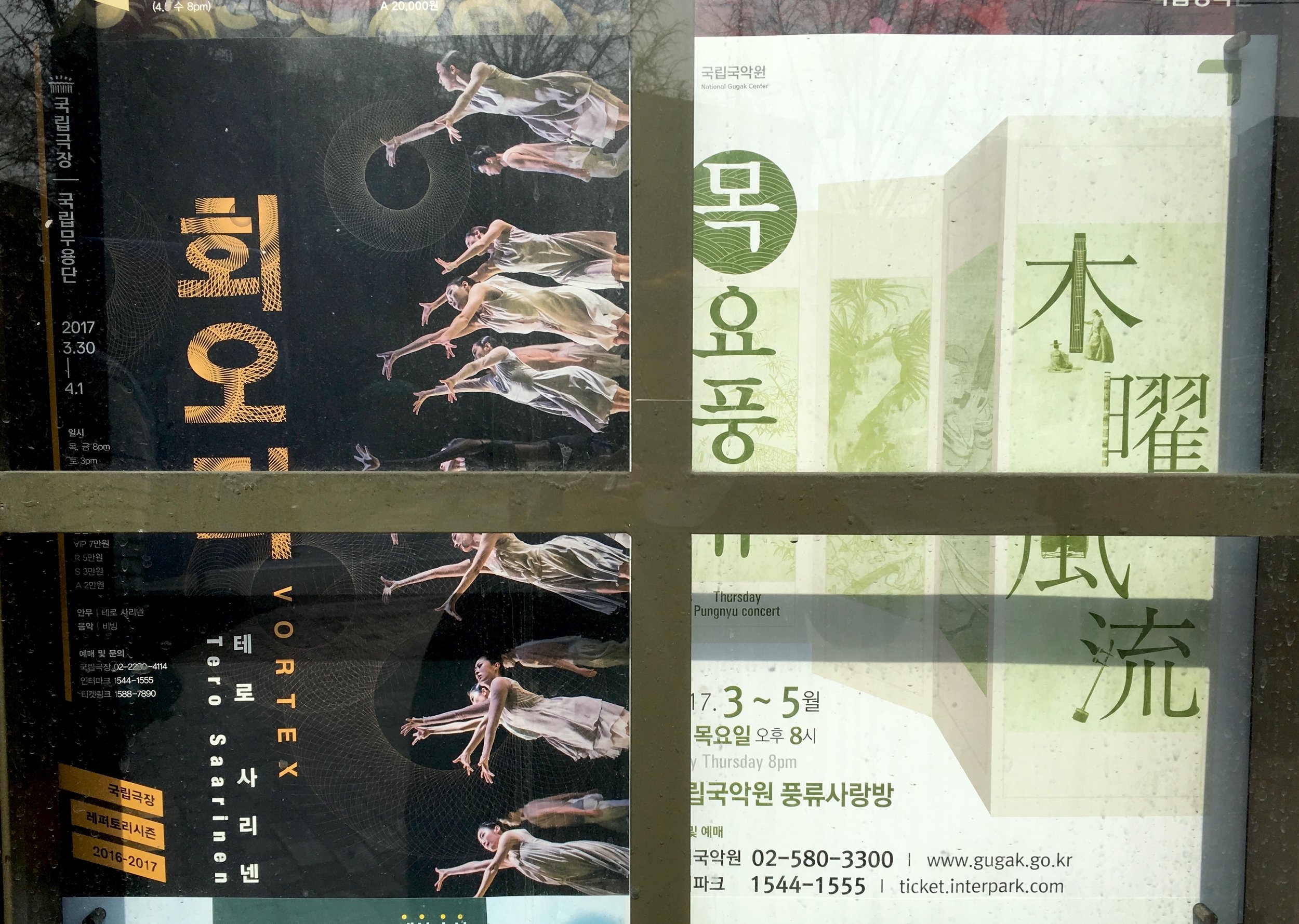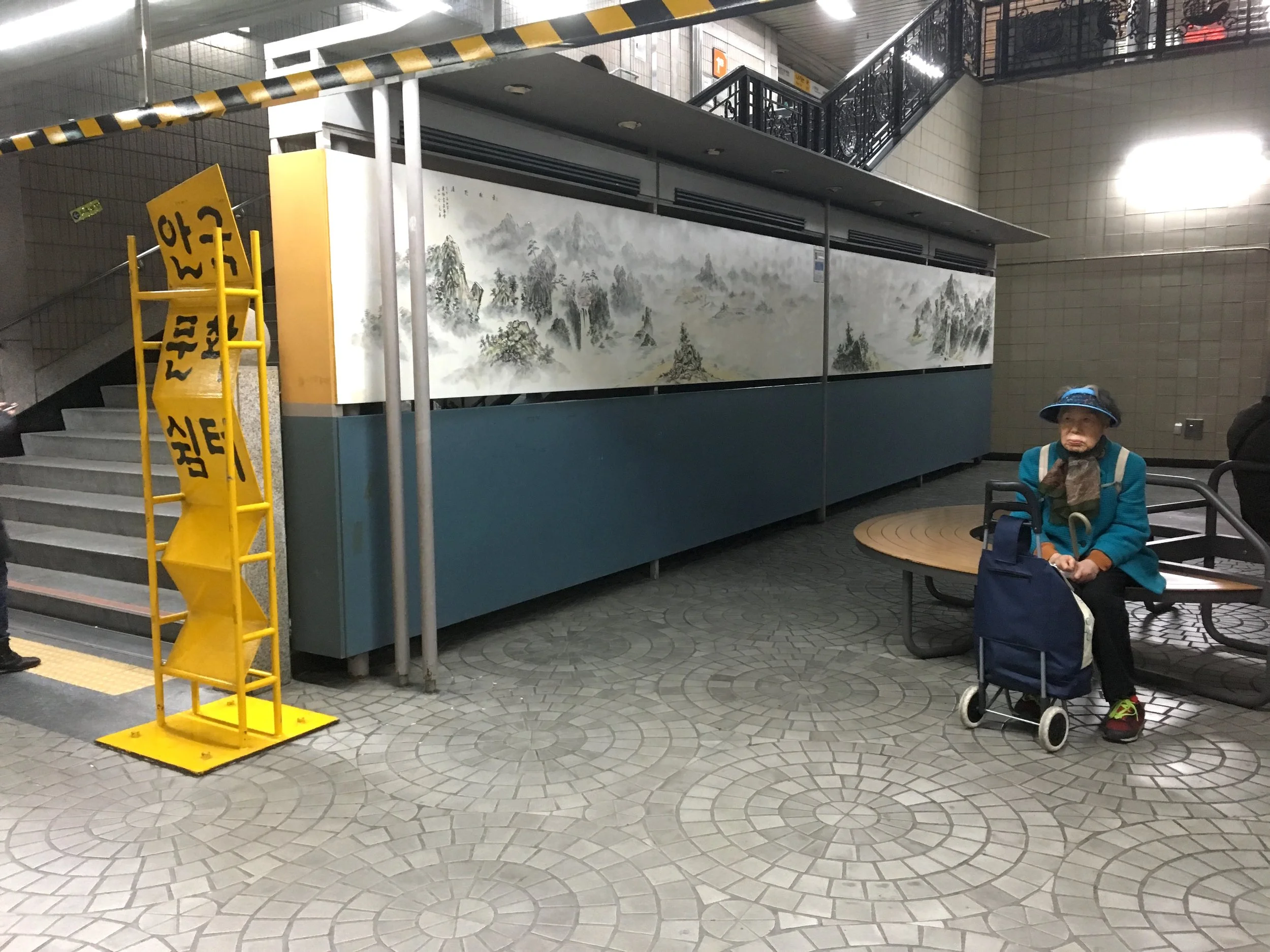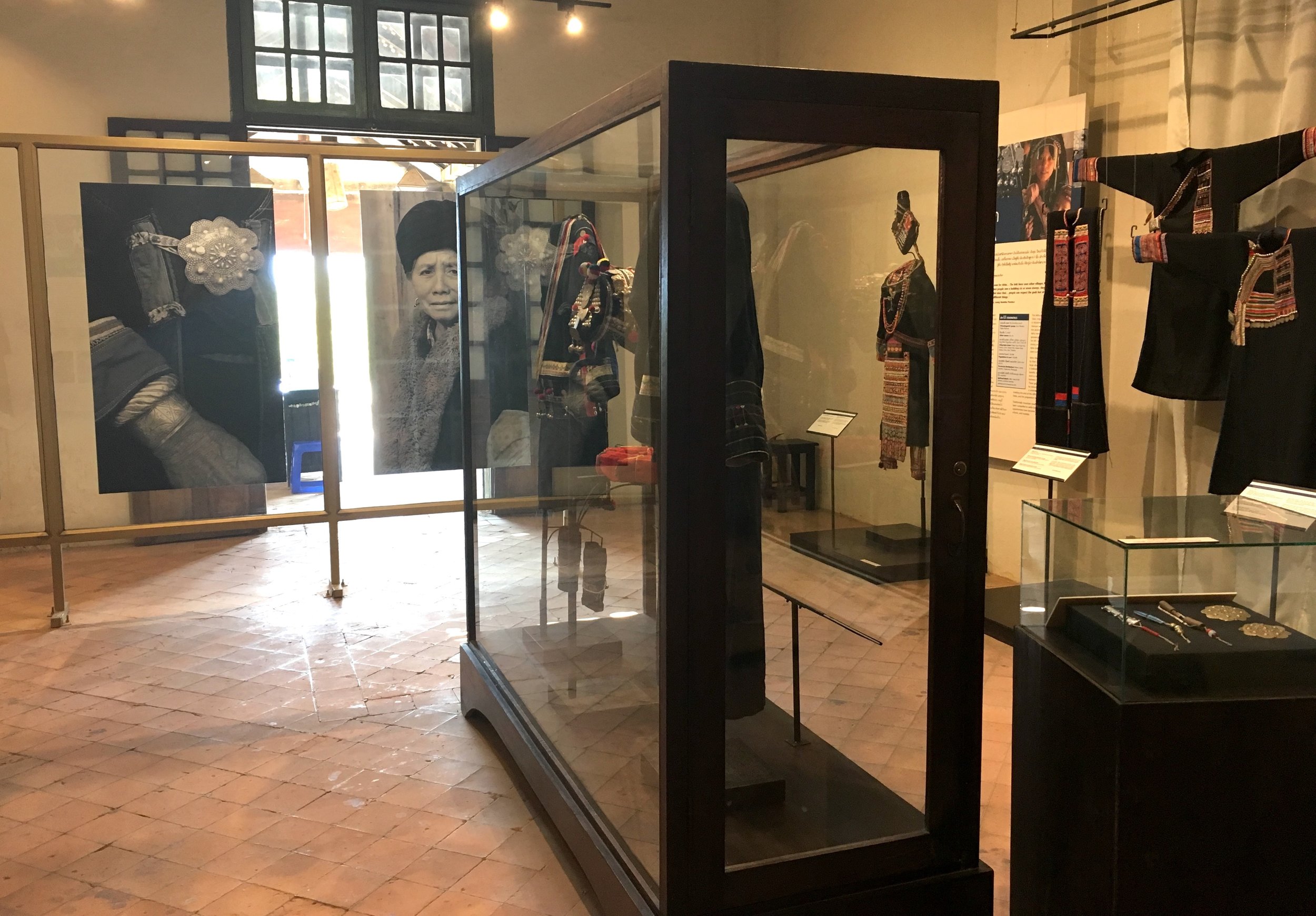Art Museum (Busan)
Busan, South Korea. This little house is part of a Children's activity area (in the basement) I wonder exactly how it is used for display, and how changeable it is.
The interior of the room uses copper taping
Busan, South Korea. This little house is part of a Children's activity area (in the basement) I wonder exactly how it is used for display, and how changeable it is.



The interior of the room uses copper taping

Busan, South Korea. Standing sidewalk inflated signs appear to be a new variation on the traditional (hanging) paper lantern signs.



Tokyo, Japan. I came across this street level plastic sign shaped like the paper lantern

Seoul, South Korea. Claims to be the largest "atypical" building in the world, by architect Zaha Hadid. The scale is dramatic, with lots of open space to situate it.


Wayfinding is totally integrated into the surface of the building

The paving is made up of variations on parallelograms, that seem to distort as if they were all being pulled toward the huge building from every direction. A slightly rough "seam" in one area catches the light and suggests a current change in water.

Huge banners drape casually over the shoulder of the building

Outdoor art installation of LED flowers. I wish I could've seen this at night

"Fornasetti: Practical Madness" is a temporary exhibition traveling from Europe... In this venue the designer had a sliding door to play with, as well as a store window along the queuing path.


Seoul and Busan, South Korea. A few poster examples




Seoul, South Korea. Display, Safety store

Seoul, South Korea. I noticed this little exhibition (of 2 large ink Paintings) being installed in a subway station. The yellow title sign caught my eye. This is a very drab space between 2 stairways

Later I noticed some folks were hanging out there


Seoul and Busan, South Korea. Detectable warnings for the sight impaired, which are seen just about everywhere.


The edge of the train platform also slopes upward

In the Busan Museum of Art


An example in a more upscale subway station


Japan as well

Seoul, Korea. A few exceptions to the otherwise "cute" approach to street art here. The yellow ribbons are symbolic of the protest movement related to the sinking of the Sewol Ferry, when hundreds of highschool students drowned. The ferry was re-surfaced, last week, after the impeachment of the President.






Seoul, South Korea. The temporary exhibition "Youth" describes itself as a "ground breaking exploration of the freedom, rebellion, innocence and passion of youth culture" with a selection of photographs, video and graphic works. It is curated into 2 areas—"Raw Energy" and "Optimism".

Some of the content may be quite powerful. Unfortunately the exhibition design distracts to the point that visitors can't focus on it. The exhibition design has no clear intention or restraint. In this case that means too many different design strategies (chain link fencing, about five structural vocabularies, floor graphics, dark and neon lighting, sound, etc). The design intention feels gratuitous and it's presence adds noise to the experience, instead of enhancing it, with respect.




Obviously the goal is to convey the raw and optimistic, but less would be so much more. One or two strategies alone would've been expressive enough, with respect to the content. For instance, the projection of large video onto plywood, like this:

Or the energetic angled "stance" of supports like this:

Or the use of the floor like this:

The majority of visitors are more interested in taking selfies in the exhibition than reflecting on the content of the exhibition. This could be seen as another indication of the design's failure, evidence that the visitors are not interacting directly with the content, perhaps because the exhibition design sensationalizes it. Or it could be seen as a missed design opportunity to support and engage visitors who want to reflect on themselves within the exhibition.
Seoul, South Korea. The Music Library (Hyundai) incorporates the work of street artists into the building. An exciting sloping floor transitions from the informal outside busking area directly into the cafe/lobby entry area.



Seoul, South Korea. The beautiful Arario Museum (in Space) by Architect Kim Swoo-geum.



"If all relationships were to reach equilibrium then this building would dissolve" seems to be a reference to an English exhibition about asylum seekers, and equality (MIMA)...



Seoul, South Korea. Magazine B, published by Joh & Company, is an ad free publication offering an independent perspective on well balanced brands around the globe. I imagine that this magazine is well known, but to me it's a new discovery. Each thick issue focuses on one brand, reporting in great depth and from many angles. It's really exciting to see such a thorough study of design. And so well designed as a publication.


I chose the "Airbnb" issue as an example, because as a traveler I am literally living on airbnb right now. Here are a few spreads.






Luang Prabang, Laos. Beeline is a mobile network. Continuing proof that Milton Glaser's graphic design concept remains very much alive, in reappropriation, 40 years later...

Seoul, South Korea. Another example, the city branding, with a twist



Luang Prabang, Laos. The Tat Kuang Si Bear Rescue Center is little zoo/interpretative center that raises money for the rescue of bears abandoned and/or traumatized by poaching activities and trade of wildlife (bear bile is used for medicinal purposes in China).

The approach to interpretation here is anthropomorphic, to the extreme, probably to emphasize that bears are worthy of our moral care and consideration. They seem to have gone over some line however, with the individual bear labels, written in first person. They made me squirm.



Here is a cage you can crawl into. The tone of the text is accusatory, as if the visitor is assumed guilty of wrong thinking, and needs to be reprimanded. In this scenario the visitor is shamed.


Bears around the world wall photo op

Luang Prabang, Laos. The mission of the Traditional Arts & Ethnology Centre is to promote learning and exchange, appreciation and pride in the ethnology and artisanal heritage of Laos. TAEC stimulates investment and preservation of crafts and sustainable livelihood, and recognizes the role of the environment with a small ethnobotanical garden on site. Their interpretation represents a contemporary point of view, and appeals directly to the tourist audience, in a subtle, thoughtful manner.

Throughout their small exhibition space, strong photography (on staff) connects the beautiful clothing to real people and their communities.



A few text examples:
"This hat was made by a Mong woman in Minnesota as a gift to her cousin in Laos..."
"...These days, factory reproductions made with fluorescent printed polyester are also common."
"...mothers will spend many months preparing ornate costumes for their daughters and sons to wear, and some will request sequins, fabrics, and new designs to be sent from overseas relatives."
"Every Akha Nuqui woman carries a needle case under the waist of her tunic for sewing and embroidery. Traditionally made of bamboo, modern designs use everything from scrap metal to plastic pens."

Along with a thorough overview of the main Lao ethnic groups, and the many subgroups, is this general statement:

On the subject of our changing world and cultural identity:

Several Interactive boxes invite visitors to identify, by touch only, whether a material is natural or synthetic. A opportunity to say more about factors of environment, labor, cost, and aesthetics.

An elaborate exhibition explores the specific use of beads from the plant "Job's Tears" by many cultures on different continents, expanding their theme to a world-wide perspective. TAEC gives specific tips on how to identify what is truly handmade, and how to bargain respectably. In this way, without pointing to tourists directly, they're able to educate and sensitize them to their role as buyers.

A cozy little cafe.

As part of the activity area, (beyond the store and next to the cafe), authentic clothing is provided for kids to try on.


The call for donations gives clear choices in terms of where the donor's money is allocated. 50% of store sales go back to the artisans, mostly rural minority women. Financial details are explained openly in signage.

A documentary video monitor is placed right at the exit, without good seating, which seems disconnected, except for those who linger at the little cafe or activity area.

Siam Reap, Cambodia. The Cambodian Landmine Museum and Relief Centre, founded by Aki Ra, (Eoun Yeak) educates visitors about the dangers of landmines, and evolved as a way to fund his efforts to clear the country of 3-5 million remaining mines. Long (and amazing) story short, Aki Ra was conscripted as a child soldier, eventually by 3 different armies. Later he devoted himself to clearing land mines, about 50,000 of them so far. Many of them he had set himself, years earlier, and for many years he cleared them by himself, using only a stick and a knife. The museum also supports his center for at-risk children, which evolved from his own adopted family of landmine victims. Currently, there is a plan to add a teaching farm to the property.


The American narrator on the English audio guide is very thorough and informative about the complicated history of the war in Cambodia. It is no-nonsense and to the point, often using the phrase "The problem is..."

A collage of original snapshots in the entry chronicles the organic history of the museum from 1997-2007.

The centerpiece of the little compound is a pavilion full of cleared mines, in a small pool.

"Do not touch" has special meaning here. Of course all the mines on display are cleared. But it's critical not to allow visitors to touch them in the museum, to reinforce the message that they should never be touched when found in the ground. The audio emphatically repeats the admonition to "never touch a mine". It appears that when the museum first opened, the mine collection was displayed out in the open, and later they enclosed them in vitrines.

The paintings in the exhibition rooms are by Aki Ra. There are also murals all around the outer walls. The children have their own artroom at the Relief Centre, and their paintings are also on exhibition in a separate room.

A video loop of various documentaries.

The final exhibition room asks the visitors for their support, with the most interesting combination of elements, including the children's artwork.



In the side courtyard are two related exhibitions which might be temporary, but appear to have been there for a while. One is "The Rescuers: Picturing Moral Courage" with portraits of everyday heroes, like Aki Ra, from around the world. Banners, in Khmer and English, are strung between the trees.



The second Exhibition "Fatal Footprint" by Handicap International, shares the same outdoor space, but uses 2 large boxes.



I am inspired by museums like this that "evolve" organically out of real world issues and community need & service. The story comes from the inside out. The staff and community are the content, the presentation, and the solution. A thoughtful amenity by the entry—a hammock shed for tuk tuk drivers.

Phnom Penh, Cambodia. Large printed construction site wrappers, intended to conceal and protect construction sites, also have a theatrical quality, like stage sets on the street. They conceal the behind-the-scenes activity, and also reveal it with an image of the thing (being created) inside it. Translucent packaging/marketing. The overlapping panels here allow a narrow sideways peak inside. Parts of the neighboring buildings are included in this image, adding to the surreal play between reality and image.





Siam Reap, Cambodia. The translation of this wayfinding sign makes it more enticing, somehow. Not only choice, but subtle ambiguity and promise.

Phnom Penh, Cambodia. Tuol Sleng Genocide Museum, aka S21, is on the site of a high school used by the Khmer Rouge as a secret security prison from 1975-79. Prisoners were held and tortured here, before being executed at the "killing fields" outside the city, now the site of the Choeung Ek Memorial museum, one of 150 execution centers around the country. Approx. 2 million Cambodians, 1/4 of the population, were killed by the Khmer Rouge. Most visitors to Phnom Penh visit both these museums.
Tuol Sleng
Local tour guides are available, but most visitors choose the audio guides, available in many languages. Audio allows them to retreat into a private experience of this very painful history. Seating is critical, and benches are all around the site.

The audio narrator repeatedly cautions the visitor about difficult content. He encourages them to remain outside exhibits they don't feel comfortable seeing, or skip audio sections they're not comfortable listening to. Detailed first hand stories are available using separate clip #s, providing choices, and a buffer. I watched one foreign visitor with several young children (of different ages), monitoring their experience carefully. She listened to each audio section first, then interpreted and paraphrased it to her children. She previewed each exhibit room first, before deciding whether to bring the children in to see it or not. The children had to wait at each stop for her to prepare. Acting as a custom personal tour guide was clearly hard work for her, and their visit was a slow process.

There is very little overt design at Tuol Sleng. Presentation is simple, with no expressive design treatments. Prison rooms are left as is, and documentary photographs taken by the Khmer Rouge are the main content. Display techniques are old fashioned, signage is spotty and illegible. The building, the photos and the audio provide the haunting experience. Imagine the experience of local families coming here searching for their own missing relatives in the photo archives.




How much is too much? When does morbid fascination and sheer revulsion take over the visitor's awareness, preventing them from experiencing other forms of reflection? When does the horror become paralyzing, instead of motivating in a constructive way? It appears that nothing is censured here, perhaps because what is most shocking is most memorable. The narrator reminds us that we, as visitors are now witness, and the "holders" of history and it's lessons.

2 large outdoor billboard photos are the only design statement on the grounds.

Would less be more? How are the needs of locals different from those of foreigners? Two small green courtyards provide a safe zone for visitors, empty except for the memorial itself. A meditation room with scheduled chanting sessions, is available for all visitors at any time. Finally, at the end of the audio, extra clips with a focus on healing are provided. Visitors can sit on a bench outside, listen to the powerful Smot, song of sorrow, and weep freely if needed.
Choeng Ek Memorial
The "Killing Fields" memorial is located outside of the city, at the outdoor site of mass graves. There are no remaining buildings. The interpretation is very similar to Tuol Seng, using the same approach to the audio guide supplemented with (longer) personal stories. The visceral sense of brutality is just as strong, in a different way. Without photos of the victims, the museum seems more useful for school groups, as an education center. There is a long looped path around a pond to follow while listening to stories. It is un-nerving to see fresh bones revealed as the ground is constantly shifting. The rawness of the wound is palpable, and the need for a place to process national grief.






The museum's spirit house.

Phnom Penh, Cambodia. Housed in beautiful Khmer architecture, the National Museum of Cambodia is as much outdoors as inside. Birds fly freely through the exhibition spaces and land on exhibits.

Some of the ancient sculptures have been given offerings. It's a small thing, that makes the official museum feel more like a living institution than just a repository for valuable old things.

Somebody worked hard on the elaborate support structures for these dancers

And maybe all museums should have their own spirit house?


A few postings on a visitor feedback wall in a temporary exhibition.

